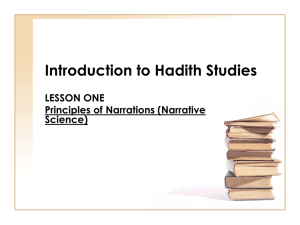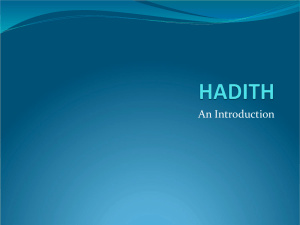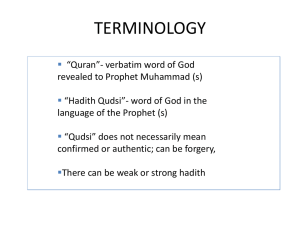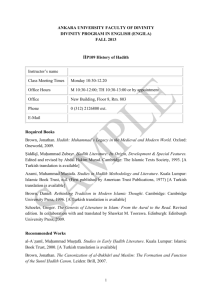The Prophetic Sunnah - Summer Nights 2010 is here!
advertisement
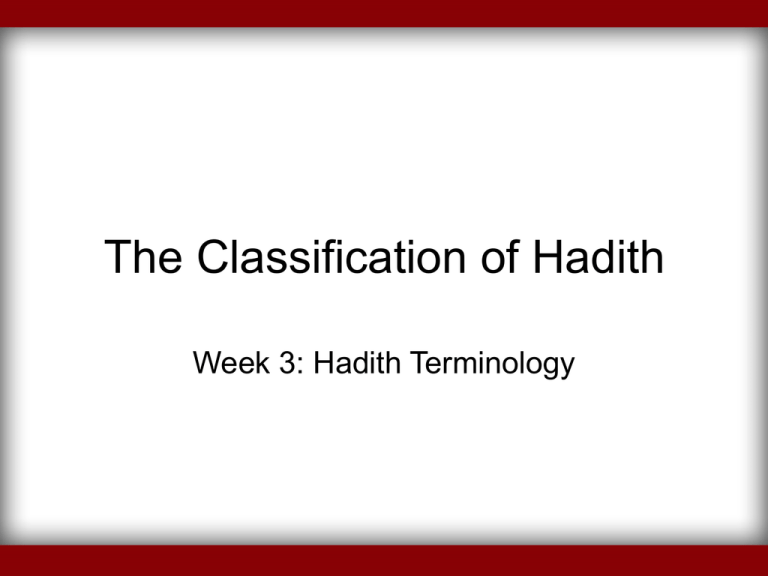
The Classification of Hadith Week 3: Hadith Terminology Components of a Hadith • Sanad or Isnad o Information about the path of the narration. o Recollection of how the narration traveled. • Matn o The text of the hadith whose meaning is desired. o Speech which has been carried by the particular sanad. A Complete Hadith Importance of the Sanad • "The isnaad is from this religion. Had it not been for the isnaad, anyone could have said whatever they desired" - ibn al Mubarak • "Knowledge is gone when the isnaad is gone." - Awzai' • "The isnaad is the weapon of the believer. If he doesn't have a weapon with him, then with what will he fight?" - Thawri • "Between us and the innovators and liars are trustworthy men." - ibn al Mubarak Foundations of the Science • Knowledge of the laws that determine the status of the sanad and matn. • Knowledge of the laws that lead to understanding the status of the narrator and narration. • The subject matter of the science is the study of the sanad and matn. What's the Purpose and Goal? 1. To determine and understand what is accepted from the reports and acted upon. 2. To determine and understand what is rejected from the reports and not to be acted upon. Its Importance and Status • Most Fundamentally Important in Understanding the other Sciences of Islam o Tafseer o Fiqh o Hadith o Aqeedah Types of Mutoon • Marfoo' o Marfoo' in its Ruling Sahaba speaks about the unseen Sahaba gives a ruling which can only be known by the Prophet. "We used to do this during the Prophet's life." "From the sunnah is..." "We were commanded to do..." "We were prohibited from..." • Mawqoof • Maqtoo' First Method of Classification • How Did the Hadith Reach Us? o Is the Hadith True or False? True False • Either reached us in a way that one cannot deny its truth or in a way that one must investigate the truth of the statement. • Multiple Ways where one cannot deny - Mutawaatir • Limited Paths - Ahaad Hadith Mutawaatir • A report in which the narrators have reached a number that compels the mind to accept that it could not have been fabricated. Conditions 1. Large Number of Narrators 2. The Near Impossibility of Collaborating upon a Lie 3. Large Number of Narrators in each generation 4. Must Have been Seen or Heard (Senses) 5. Mandates that the Report is True and is a Fact Ahaadith Ahaad • What does not meet the conditions of tawaatur, nor mandate knowledge, despite the number of narrators. • Levels of Ahaad o Mashoor or Mustafeed (3+) o 'Aziz (2) o Ghareeb (1) Classification of Authenticity and Acceptability Accepted Hadith Two Types of Saheeh 1. Intrinsically Saheeh - In and of Itself 2. Extrinsically Saheeh - Due to another Hadith Two Types of Hasan 1. Intrinsically Hasan - In and of Itself 2. Extrinsically Hasan - Due to another Hadith Intrinsically Saheeh • A report that has a connected, unbroken sanad, narrated by honest and extremely reliable individuals, and is free from any flaws (shadh or ma'lool) Five Conditions 1. Continuity in Narration 2. Integrity of Narrator - Honest, Just, Trustworthy 3. Reliability of Narrator - Memory and Accuracy of Writing 4. Not Shaadh 5. Not Ma'lool Explanation of The Conditions 1. Continuity - The Hadith was directly taken from the above narrator without any gaps or holes in narration. 2. Integrity • Whoever stays away from the major sins, and generally stays away from minor sins. • Who carries himself with taqwa and abstains from lowly behavior and sins. 3. Precision and Reliability • Precision of Memory • Precision of Writing Continued... 4. Not Shaadh - 2 Types of Shudhoodh • Singular Narrations that are not open to consideration • Contradictory to another narration that is related by someone more precise and reliable. 5. Not Ma'lool - Flaw that is very slight and not easily detectable. • No exact formula to discover such flaws. • Requires Mastery and Expertise • Examples o Mix up of words o Mix up of letters o Combining Parts of Narrations Example - Intrinsically Saheeh • "Actions are [to be judged] by their intentions. Each individual will receive [from Allah] only what he intended..." 1. Continuous sanad • Yahya bin Saeed al Ansaary • Mohamad bin Ibrahim al Taym • 'Alqama bin Waqqas al Laythi • 'Umar bin Khattab 2. Integrity of each narrator confirmed 3. Memory of each narrator confirmed 4. No contradiction or cause for rejecting singularity of hadith 5. No flaws (rather the opposite - all of Islam confirms it) Intrinsically Hasan • A report that has a connected, unbroken sanad, narrated by honest and reliable individuals, and is free from any flaws (shadh or ma'lool) Five Conditions 1. Continuity in Narration 2. Integrity of Narrator - Honest, Just, Trustworthy 3. Reliability of Narrator -Just a Notch Lower than Saheeh 4. Not Shaadh 5. Not Ma'lool Extrinsically Saheeh • A hadith which is intrinsically Hasan but is narrated from another path (even one) which is as strong as it or stronger. • Intrinsically Hasan + Intrinsically Hasan = Extrinsically Saheeh • Intrinsically Hasan + Intrinsically Saheeh=Extrinsically Saheeh o o Description of multiple narrations, not one narration. Removes any slight doubt on the narrator's memory. Example: "Had I not wanted to make things difficult on my ummah, I would have commanded them to use al siwaak before each prayer." (Hasan + Saheeh) Extrinsically Hasan A hadith which has some weakness in its isnaad (due to a slightly poor memory or irsaal) but is narrated from another path that is similar to it or stronger. • Only consider weakness in the sanad, not in the matn • Someone who is unknown, mursal, or mixed up later in life due to old age or other. • Don't consider severe weakness like... o Possible Liar or a fasiq o Horrible Memory o Extremely Forgetful and lots of Mistakes • Appearance of Supporting Factors - similar meaning Next Week • • • • Da'eef and its types Grading of the Narrators Acting Upon Weak Narrations Differences in Acting Upon Hadith o Differences in Grading Narrators and Hadith o Differences in Abrogation o Differences in Application o Lack of Knowledge of a Particular Hadith o Other Usooli Differences
